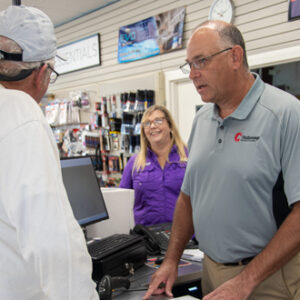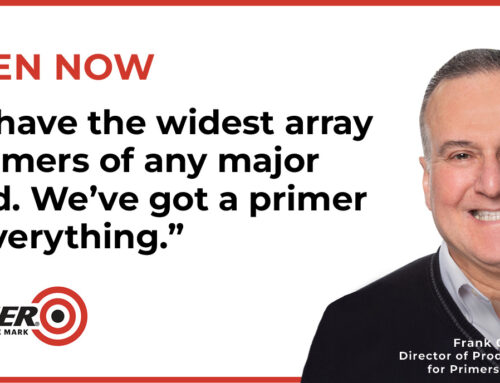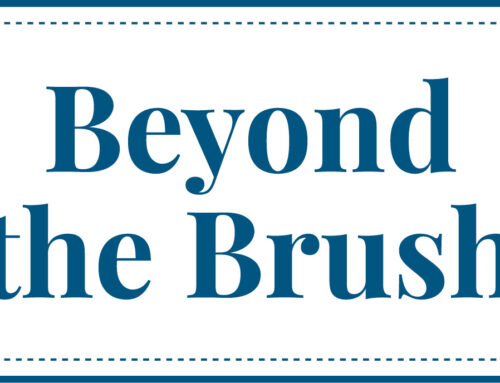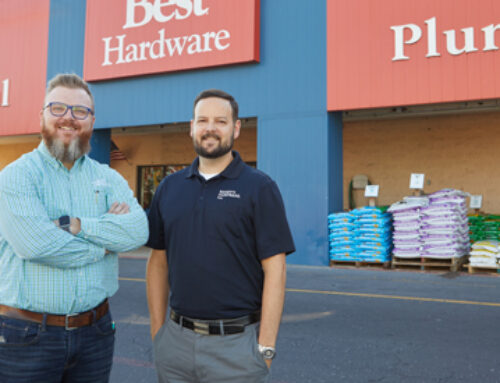We’ve come a long way since 1991, when the European Organization for Nuclear Research, home of the scientist who came up with the idea for the World Wide Web, launched the first website with text only and rudimentary hyperlinks. Now, nearly 2 billion websites vie for consumers’ attention.
To gain a piece of the digital market share, a business needs an engaging website that answers customers’ questions and allows them to get to know your brand. An effective website can also bring customers into your physical store. According to The OptiMine Index: 2022 Media & Performance Trends, an in-depth look at the cross-channel impacts of marketing channels, the in-store conversion rate for websites is 59%. The report found that an operation’s website leads to consumers choosing to shop in-store 30% more than they pick to shop online.
Whether you are launching a website for the first time or looking to make your current one more effective, follow the journey of three retailers who recently revamped their digital strategies by undergoing major website updates. Learn from their processes and glean best practices to effectively use your website to drive your digital presence.
Growth Through Evolution

When the operation’s wholesaler discontinued its e-commerce ship-to-store platform, the leadership team, including Otto and other management-level employees, began rethinking digital strategy and what they hoped to achieve with a digital presence. The company’s priorities around building a digital presence included reaching new customers and giving existing customers a new way to interact with the operation, says director of store operations Jason Fank.
“One of our goals was also to be able to track the effectiveness of any digital marketing we were planning on doing,” Fank says. “The data and analytics we gain from our website, social media and other sources are key to determining whether our strategies are successful.”
Fank oversees the marketing strategies, which are managed by Christine Byrne, who joined in a full-time marketing role in 2013. The store’s IT expert, Walt Thomas, who has been with the company since 1996, has also played a major role getting the new website off the ground.
As leadership got deeper into digital strategies, in 2022 the company’s web developer introduced them to Mountain Mojo Group, a marketing agency based in Flagstaff, Arizona, that specializes in supporting small businesses and independent home improvement companies with marketing strategies.
“Hiring a marketing firm has made all the difference; they do all the heavy lifting from content creation to data analytics,” Fank says. “Thanks to their work, we found out our customers want to interact with our brand online it’s a natural extension of the customer experience we provide in the store.”
A major focus of Handyman Hardware’s digital presence strategy was revamping the website to better reach new customers and connect with existing ones.
“Our stores have deep roots in their communities,” Fank says. “Telling our story on the site and reinforcing that story in social media posts is essential for us.”
Because we are all inundated with marketing messages every day, customers are looking for authenticity, says Rand Jenkins, founder and director of strategy for Mountain Mojo Group.
“When they get on a website, they want to see photos of people they might see in the aisles of the store,” Jenkins says. “They want to see a company that cares about the community, they want to see local.”
As the core of your company, your culture should also play a major role in developing your digital presence strategy, Jenkins says.
Fank and his team followed Mountain Mojo Group’s suggestions and worked to inject personality and authenticity into the company’s website. Handyman Hardware’s website includes an “About Us” tab at the top of the home page and a link to that page on the home page. The “About Us” page shares the company’s mission, vision and history.
“Christine, Walt and I participated in every step of the design of the new site,” Fank says. “Because none of us are experts at website development, we leaned heavily on advice from our partners, but we made all the decisions.”
Having live inventory on the website was another priority because consumers want to know if a store has the exact product they need and if the store has enough in stock, Fank says. To offer live inventory successfully, the operation had to have good SKU data, which it has gathered over the years thanks to Thomas’ efforts. The better the store’s data, the better the search function is on the site, which is critical for customers to easily find what they want to find.
In the end, the website had to deliver a great customer experience, so the site has to be easy to use, Fank says. The team also wanted to put more focus on services like installation, screen and window repair and the operation’s remodeling partnership with a local construction company in an effort to better serve customers.
“Our website is still too new to determine its impact on the bottom line, but the research I’ve read says that most customers will find the product they need on the website but come into the store to make the purchase,” Fank says. “So while the website may not pay for itself with online revenue, we expect it to drive footsteps to our stores. So far the number of visits to the site is very promising.”
Keeping Google in Mind
When Jim Praytor purchased Chattanooga Paint and Decorating in Hixson, Tennessee, in 2011, the company had a rudimentary website that was built and managed through a major paint manufacturer. A few years into ownership, on the recommendation of another local small business, Praytor hired a local independent contractor to take over the marketing of the company. This contractor built a new website, designed a new logo and started the company on a new trajectory for marketing.
“We did that for about maybe four or five years, and then I met Christi Broom through my office manager,” Praytor says.
Broom had been working for a home design company, managing a marketing budget of over $1 million, and when that company was bought out, she was looking for a new role. Praytor hired her to take over the marketing strategy, paying her a monthly fee. During the website revamp, she took input from Praytor and other employees to create a comprehensive website that appeals to customers and expands the company’s digital footprint.
“She told us what we needed to do to grow, which was the goal,” Praytor says.
While connecting with customers was important as Broom developed a new strategy for the store’s website, she focused on using the website to improve search results on Google. In the past, companies only needed a website that shared pertinent information with customers. Now, a website needs to have all the necessary components to meet Google’s search result algorithms.
“Today, a website needs to talk to Google,” Broom says. “A website needs more content, pictures and other information that maybe the consumer doesn’t need to read, or never will read, in order to show up in search results.”
Broom was able to get Chattanooga Paint’s website Google verified and has been undertaking search engine optimization (SEO) and search engine marketing (SEM) campaigns to boost the website in search results. With the SEM campaigns, the company pays for ads to show up in search results for certain keywords.
The company that hosts the Chattanooga Paint website sends an analytic report each month, and Broom is able to see the analytics for Google and the website at any time.
“Thanks to our SEO and SEM campaigns, the stores are able to show up online and be very visible when a consumer searches for the company, its products and services and even competitors in the area,” Brooms says. “Through these campaigns, we are inviting people to visit us online and in the stores and trying to stay top of mind of a consumer.”
As an added benefit, Broom uses the data collected from reports to make creative marketing decisions. She analyzes the data to see if what she has implemented is working and makes changes to get better results. She says that at times, she sees surprising trends from the consumer and uses that information to improve marketing efforts on the website, social media and beyond.
While having an effective website is key, having that website communicate with Google and pairing it with a direct and strategic marketing campaign takes your efforts to the next level, Broom says.
“It all works together as a complete organism, reaching the consumer where they are, multiple times,” Broom says. “It’s easy to slip through the online cracks if you don’t have a comprehensive strategy.”
As a paint retailer, Praytor says there are several components every business should include on its website. Contact information that is easy to find on the first page tops his list of must-haves for a website, and he also thinks photos of your staff and an “About Me” page sharing the history of the operation and its people is crucial to showing authenticity and connecting with customers. If you don’t offer e-commerce as part of your website, at minimum list the brands you carry.
“A lot of customers search for and are looking for specific brands online, so displaying at least your top brands on your website can help drive traffic to the site and then into your store,” Praytor says. “Just be careful not to overwhelm customers with information, especially on the first page. Offer a nice basic home page and clarify with easy navigation to click through to other pages and additional information.”
Broom’s digital strategy and new website especially have brought in a lot of new faces, including homeowners and DIYers. The revamped website also helped when Praytor opened a second location in Ooltewah, Tennessee, in 2019.
“Our website is really targeted to new customers, and it’s paid off as we’ve seen an increase in those consumers coming in,” Praytor says. “We’ll get anywhere from three or four to 10 or even 20 new clients a month that we don’t have in our customer database.”
An effective website is just one piece of the digital presence puzzle; Broom says it is important to incorporate social media and take advantage of online platforms like Google Business Profile and Apple Business Connect.
“Google also looks at whether you’re sharing similar content on Facebook and Google My Business as you are on your website,” Broom says. “It is important to create cohesive messaging across all of your online and digital platforms.”
What Customers Want
When James and Megan Coté purchased Osterville Hardware in 2010, the store was in danger of going out of business. The Cotés poured time, energy and money into revamping the physical store, adjusting merchandising and product assortments and providing a better flow. They also turned their sights on the store’s digital presence, including delving into social media and making adjustments to the store’s website.

The process for developing a full digital presence strategy evolved from there, and led to Megan creating a new website using the website hosting and design platform Wix. Using Wix allows the Cotés to personalize the website and simplify the process of managing the site.
The marketing and digital tasks now fall on part-time marketing director Meaghan Didato, who had been a sales associate and expressed interest in running the operation’s social media channels. The Cotés empowered Didato to take on the social media duties, which led to her eventually completing a minor in marketing and taking over all marketing strategy for the store.
“We developed a position for her last year, and she’s been great in that role ever since, which has taken those tasks off our plates and allowed us to focus on other areas of the business more,” James says.
Two to three times a year, Didato reviews the website with the Cotés to ensure it is still effectively communicating the operation’s message and connecting with customers. While the Cotés don’t use SEO frequently as part of their digital strategy, they do track Google Analytics and have a monthly digital ad budget that has helped drive traffic to the website. They have not gone into full e-commerce, but do offer online shopping through the store’s wholesaler.
“Our website might be simple, but we strive to give customers what they need,” James says. “We think our site achieves that goal.”
Who to Hire
Where to Find Help Building Your Digital Presence
Regardless of the size of your operation or your budget, a comprehensive digital strategy, including a website and social media, is possible. Rand Jenkins, founder and director of strategy for Mountain Mojo Group, a marketing agency that specializes in working with small businesses and hardware stores, offers several options depending on your operation’s annual revenue.
At a minimum, an office administrator, technology savvy sales association or assistant manager who has eight hours a week to spend on digital marketing can be an option.
“That employee can also use that time to build out the job description and strategy in preparation for hiring a full time employee or an agency,” Jenkins says.
Store revenue of $750,000 to $2 million
Jenkins recommends hiring an independent contractor from a freelancing website like Upwork. This individual should have high ratings, at least three years of experience in communications and content creation and the ability to handle eight to 20 hours of work per week.
“For a solid U.S. contractor, you’ll pay $40-$100 an hour, and for an offshore contractor who may or may not be reliable, you’ll pay $5-$25,” Jenkins says. “You’ll also need someone from your team to have a firm understanding of marketing strategy to be the point person for communications and coordination.”
Store revenue of $2 million to $5 million
At this level, a full-time equivalent (FTE) can be a good option to lead your marketing efforts. This person is typically in charge of social media and is decent at graphic design and photography, but most importantly understands how to build relationships and connect with people in a genuine way, Jenkins says. Expect to pay a salary of $52,000 to $60,000 with a return on investment goal of 1-2% growth from their efforts.
Store revenue of $5 million to $9 million
For larger organizations, an agency can provide the level of marketing strategy and implementation you need to be successful. Jenkins recommends an agency with solid reviews, at least three years of business and a solid understanding of marketing strategy with the ability to create and distribute impactful content.
“Ask them how they report on their work to make sure they’re measuring and sharing with you their results,” he says. “For a group that will move the needle for your stores, you can expect to pay $1,500-$15,000 a month depending on your budget and growth goals.”








